 In May 2008 PLoS One researchers from California Academy of Sciences and University of Guelph analyze morphology and COI barcodes of Madagascar ants in genera Anochetus and Odontomachus. Their taxonomic revision is “based on arthropod surveys in Madagascar that included over 6,000 leaf litter samples, 4,000 pitfall traps, and 8,000 additional collecting events…from 1992 to 1996”–phew! Researchers Fisher and Smith used COI sequence data of 501 individuals to speed their analysis and provide an accessible reference for future work.
In May 2008 PLoS One researchers from California Academy of Sciences and University of Guelph analyze morphology and COI barcodes of Madagascar ants in genera Anochetus and Odontomachus. Their taxonomic revision is “based on arthropod surveys in Madagascar that included over 6,000 leaf litter samples, 4,000 pitfall traps, and 8,000 additional collecting events…from 1992 to 1996”–phew! Researchers Fisher and Smith used COI sequence data of 501 individuals to speed their analysis and provide an accessible reference for future work.
First, COI barcodes enable associating the various caste forms including males and females within species. Second, DNA barcodes provide an additional tool for matching names with type specimens. For example, Meusnier et al have recently applied broad-range primers to amplify a 130 base pair “universal mini-barcode” (this lies within the 648 full-length COI barcode sequence). The mini-barcode can more easily be amplified from older museum material with partly degraded DNA, and usually contains enough sequence information to associate older specimens with more recently collected material. Third, distinct genetic clusters within morphologically undifferentiated ant species suggest avenues for future study. Fourth, DNA barcodes establish a method for future workers, not skilled in ant morphology, to identify specimens. For example, not many persons will be able to recognize males of Malagasy Anochetus by “shortest distance between lateral ocellus and margin of compound eye smaller than maximum length of ocellus. Petiolar node as seen from front or rear with lateral corners rounded, without acute spine or sharp tooth.” There are multiple high-resolution photos of each described species posted on AntWeb; I find these just as mysterious as the text descriptions.
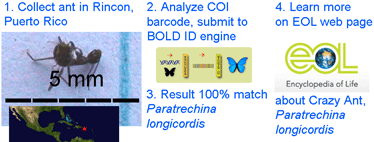 As a test of how DNA barcoding might work for the interested ant novice, I collected the tiny specimen at left in Rincon, Puerto Rico, and submitted its COI barcode to BOLD ID engine. This gave 100% match to Paratrechina longicornis, and on the corresponding Encyclopedia of Life page, I learned the common name is “Crazy ant”, an invasive species found worldwide, plus found many interesting links including to AntWeb P. longicornis pages. It was amusing to learn that Crazy ants overran Biosphere II and were one factor leading to demise of the project (link to NYT article). Of course not all 100+ Paratrechina spp are in BOLD, and there may be a closely-related species with similar or identical COI barcode sequences as P. longicordis, so more work is needed to build up the database!
As a test of how DNA barcoding might work for the interested ant novice, I collected the tiny specimen at left in Rincon, Puerto Rico, and submitted its COI barcode to BOLD ID engine. This gave 100% match to Paratrechina longicornis, and on the corresponding Encyclopedia of Life page, I learned the common name is “Crazy ant”, an invasive species found worldwide, plus found many interesting links including to AntWeb P. longicornis pages. It was amusing to learn that Crazy ants overran Biosphere II and were one factor leading to demise of the project (link to NYT article). Of course not all 100+ Paratrechina spp are in BOLD, and there may be a closely-related species with similar or identical COI barcode sequences as P. longicordis, so more work is needed to build up the database!
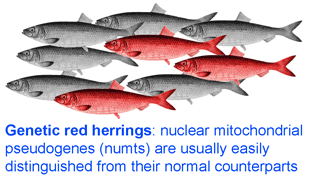 Pseudogenes, first described by
Pseudogenes, first described by 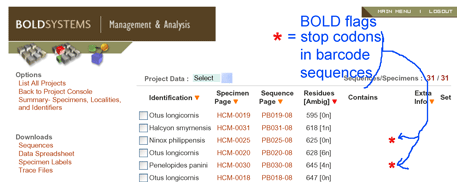
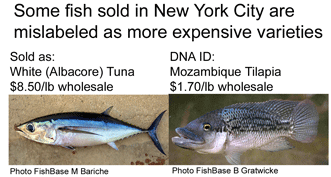 In
In 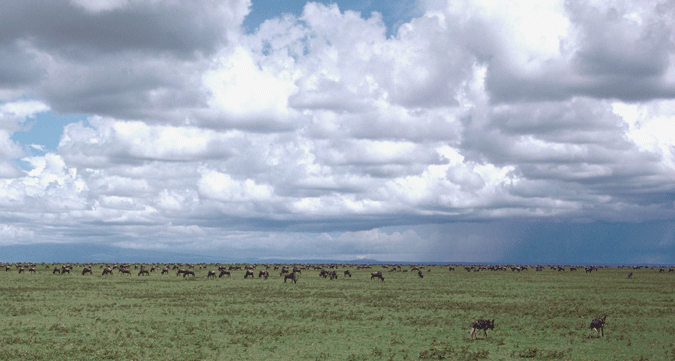
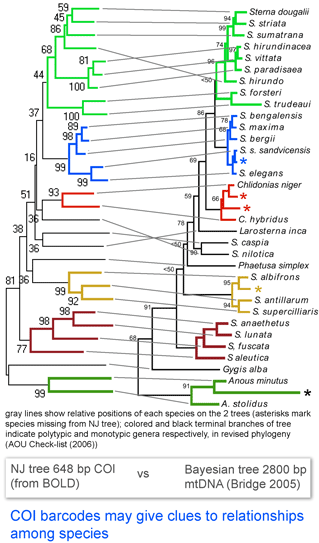 Here I look at one example from birds, comparing differences among COI barcodes to a recently revised phylogeny of terns (subfamily Sternini). According to
Here I look at one example from birds, comparing differences among COI barcodes to a recently revised phylogeny of terns (subfamily Sternini). According to 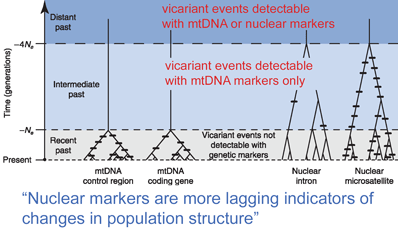 In
In 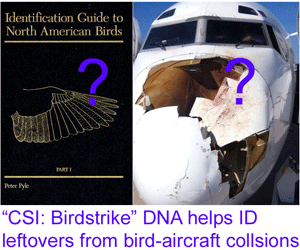 In
In  About 10% of named insect species are parasitoids, mostly wasps, but recognizing these often minute insects can be tricky. In
About 10% of named insect species are parasitoids, mostly wasps, but recognizing these often minute insects can be tricky. In 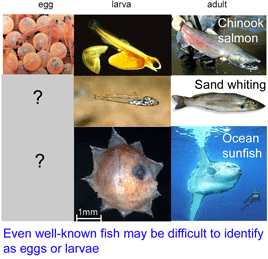 In
In 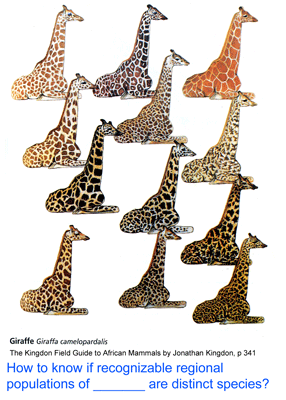 How many giraffes were onboard the Ark? Giraffes are classified as a single species, Giraffa camelopardalis, with five to nine subspecies proposed based on regional variation in pelage (coat pattern). In
How many giraffes were onboard the Ark? Giraffes are classified as a single species, Giraffa camelopardalis, with five to nine subspecies proposed based on regional variation in pelage (coat pattern). In 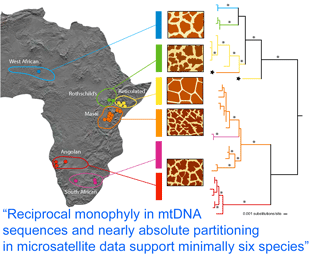 Analysis of 14 nuclear microsatellites from 381 individuals at 18 locations (it is not clear whether these are the same individuals as above) recovered the same six groups and suggested additional genetic subdivisions within some groups. Although at least some of the genetically and pelage-defined clusters have overlapping or adjacent ranges without geographic barriers, only three (0.8%) of individuals were identified as hybrids. These findings raise interesting questions about giraffe biology; for example, is there behavioral isolation perhaps based on visual recognition of pelage patterns?
Analysis of 14 nuclear microsatellites from 381 individuals at 18 locations (it is not clear whether these are the same individuals as above) recovered the same six groups and suggested additional genetic subdivisions within some groups. Although at least some of the genetically and pelage-defined clusters have overlapping or adjacent ranges without geographic barriers, only three (0.8%) of individuals were identified as hybrids. These findings raise interesting questions about giraffe biology; for example, is there behavioral isolation perhaps based on visual recognition of pelage patterns?